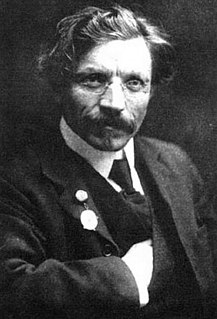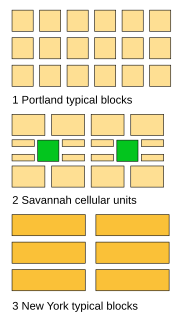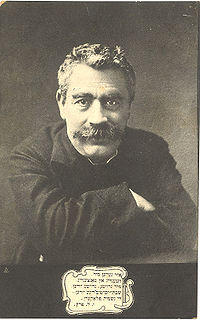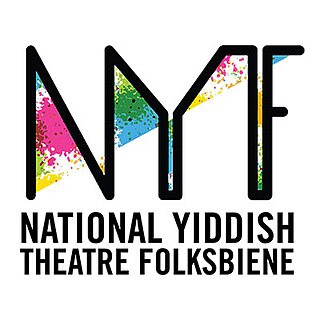
Broadway is a road in the U.S. state of New York. Broadway runs from State Street at Bowling Green for 13 mi (21 km) through the borough of Manhattan and 2 mi (3.2 km) through the Bronx, exiting north from New York City to run an additional 18 mi (29 km) through the Westchester County municipalities of Yonkers, Hastings-On-Hudson, Dobbs Ferry, Irvington, and Tarrytown, and terminating north of Sleepy Hollow.

Houston Street is a major east-west thoroughfare in Lower Manhattan in New York City. It runs the full width of the island of Manhattan, from FDR Drive along the East River in the east to the West Side Highway along the Hudson River in the west. The street is divided into west and east sections by Broadway.

Alphabet City is a neighborhood located within the East Village in the New York City borough of Manhattan. Its name comes from Avenues A, B, C, and D, the only avenues in Manhattan to have single-letter names. It is bordered by Houston Street to the south and by 14th Street to the north, along the traditional northern border of the East Village and south of Stuyvesant Town and Peter Cooper Village. Some famous landmarks include Tompkins Square Park and the Nuyorican Poets Cafe.

The East Village is a neighborhood on the East Side of Lower Manhattan in New York City. It is roughly defined as the area east of the Bowery and Third Avenue, between 14th Street on the north and Houston Street on the south. The East Village contains three subsections: Alphabet City, in reference to the single-letter-named avenues that are located to the east of First Avenue; Little Ukraine, near Second Avenue and 6th and 7th Streets; and the Bowery, located around the street of the same name.

Solomon Naumovich Rabinovich, better known under his pen name Sholem Aleichem, was a Yiddish author and playwright. The 1964 musical Fiddler on the Roof, based on his stories about Tevye the Dairyman, was the first commercially successful English-language stage production about Jewish life in Eastern Europe. The Hebrew phrase שלום עליכם literally means "[May] peace [be] upon you!", and is a greeting in traditional Hebrew and Yiddish.

The Lower East Side, sometimes abbreviated as LES and sometimes referred to as Loisaida, is a neighborhood in the southeastern part of the New York City borough of Manhattan, roughly between the Bowery and the East River from Canal to Houston streets. Traditionally an immigrant, working-class neighborhood, it began rapid gentrification in the mid-2000s, prompting the National Trust for Historic Preservation to place the neighborhood on their list of America's Most Endangered Places.

The Commissioners' Plan of 1811 was the original design for the streets of Manhattan above Houston Street and below 155th Street, which put in place the rectangular grid plan of streets and lots that has defined Manhattan to this day. It has been called "the single most important document in New York City's development," and the plan has been described as encompassing the "republican predilection for control and balance ... [and] distrust of nature". It was described by the Commission that created it as combining "beauty, order and convenience."

Rivington Street is a street in the New York City borough of Manhattan, which runs across the Lower East Side neighborhood, between the Bowery and Pitt Street, with a break between Chrystie and Forsyth for Sara D. Roosevelt Park. Vehicular traffic runs west on this one-way street.

8th Street is a street in the New York City borough of Manhattan that runs from Sixth Avenue to Third Avenue, and also from Avenue B to Avenue D; its addresses switch from West to East as it crosses Fifth Avenue. Between Third Avenue and Avenue A, it is named St. Mark's Place, after the nearby St. Mark's Church in-the-Bowery on 10th Street at Second Avenue.

Isaac Leib Peretz, also sometimes written Yitskhok Leybush Peretz was a Yiddish language author and playwright from Poland. Payson R. Stevens, Charles M. Levine, and Sol Steinmetz count him with Mendele Mokher Seforim and Sholem Aleichem as one of the three great classical Yiddish writers. Sol Liptzin wrote: "Yitzkhok Leibush Peretz was the great awakener of Yiddish-speaking Jewry and Sholom Aleichem its comforter.... Peretz aroused in his readers the will for self-emancipation, the will for resistance against the many humiliations to which they were being subjected."

Peretz Hirshbein was a Yiddish-language playwright, novelist, journalist, travel writer, and theater director. Because his work focused more on mood than plot, he became known as "the Yiddish Maeterlinck". His work as a playwright and through his own short-lived but influential troupe, laid much of the groundwork for the second golden age of Yiddish theater that began shortly after the end of World War I. The dialogue of his plays is consistently vivid, terse, and naturalistic. Unusually for a Yiddish playwright, most of his works have pastoral settings: he had grown up the son of a miller, and made several attempts at farming.

4th Street is a street in Lower Manhattan, New York City. It starts at Avenue D as East 4th Street and continues to Broadway, where it becomes West 4th Street. It continues west until the Avenue of the Americas, where West 4th Street turns north and confusingly intersects with West 10th, 11th, 12th, and 13th Streets in Greenwich Village. Most of the street has the same 40-foot (12 m) width between curbstones as others in the prevailing street grid, striped as two curbside lanes and one traffic lane, with one-way traffic eastbound. The portion from Seventh to Eighth Avenues is westbound and is approximately 35 feet (11 m) wide, a legacy of the original Greenwich Village street grid. The section of four short blocks from MacDougal Street to University Place which forms the southern border of Washington Square Park is called Washington Square South.

West Broadway is a north-south street in the New York City borough of Manhattan, separated into two parts by Tribeca Park. The northern part begins at Tribeca Park, near the intersection of Avenue of the Americas, Walker Street and Beach Street in Tribeca. It runs northbound as a one-way street past Canal Street and becomes two-way at the intersection with Grand Street one block farther north. West Broadway then operates as a main north-south thoroughfare through SoHo until its northern end at Houston Street, on the border between SoHo and Greenwich Village. North of Houston Street, it is designated as LaGuardia Place, which continues until Washington Square South.

The National Yiddish Theatre Folksbiene, commonly known as NYTF, is a professional theater company in New York City which produces both Yiddish plays and plays translated into Yiddish, in a theater equipped with simultaneous superscript translation into English. The company's leadership consists of executive director Dominick Balletta and artistic director Zalmen Mlotek. The board is co-chaired by Sandra Cahn and Carol Levin.

Jews in New York City comprise approximately 13 percent of the city's population, making the Jewish community the largest in the world outside of Israel. As of 2014, 1.1 million Jews lived in the five boroughs of New York City, and 2 million Jews lived in New York State overall. Jews have immigrated to New York City since the first settlement in Dutch New Amsterdam in 1654, most notably at the end of the 19th century to the early 20th century, when the Jewish population rose from about 80,000 in 1880 to 1.5 million in 1920. The large Jewish population has led to a significant impact on the culture of New York City. After many decades of decline in the 20th century, the Jewish population of New York City has seen a sharp increase in the 21st century, owing to the high birth rate of the Hasidic and Orthodox communities.

The Irving Place Theatre was located at the southwest corner of Irving Place and East 15th Street in the Union Square neighborhood of Manhattan, New York City. Built in 1888, it served as a German language theatre, a Yiddish theatre, a burlesque house, a union meeting hall, a legitimate theatre and a movie theatre. It was demolished in 1984.
Ascenzi Square is a small plaza formed by the intersection of two street grids that meet at Metropolitan Avenue in the Williamsburg neighborhood of Brooklyn, New York City. Roebling Street traverses both grids, making a slight jog to the southwest between North Fourth Street and Metropolitan Avenue. On March 29, 1939, the New York City Council designated this triangle as Ascenzi Square, in honor of brothers Joseph and William Ascenzi, residents of Williamsburg who were killed in the First World War.
Anthony Catanzaro Square is located within a traffic triangle that is the result of three street grids that meet in the Bath Beach neighborhood of Brooklyn, New York. At this junction, West 16 Street meets its northern end at the same place where Avenue Y meets its western end, both of these roads meeting Bay 50th Street.
The Gray Academy of Jewish Education is a pluralistic Jewish day school in Winnipeg, Manitoba, and the only K–12 Jewish day school in western Canada.

















